Lighting a fuse
By Colin Twiggs
April 28, 2016 6:00 p.m. AEST (4:00 a.m. EDT)
Advice herein is provided for the general information of readers and does not have regard to any particular person's investment objectives, financial situation or needs. Accordingly, no reader should act on the basis of any information contained herein without first having consulted a suitably qualified financial advisor.
The Fed quit quantitative easing more than a year ago, limiting total assets on its balance sheet to $4.5 trillion. But more than $2.5 trillion of cash injected into the financial system had been deposited straight back into the Federal Reserve system by banks as excess reserves, earning 0.25% p.a.
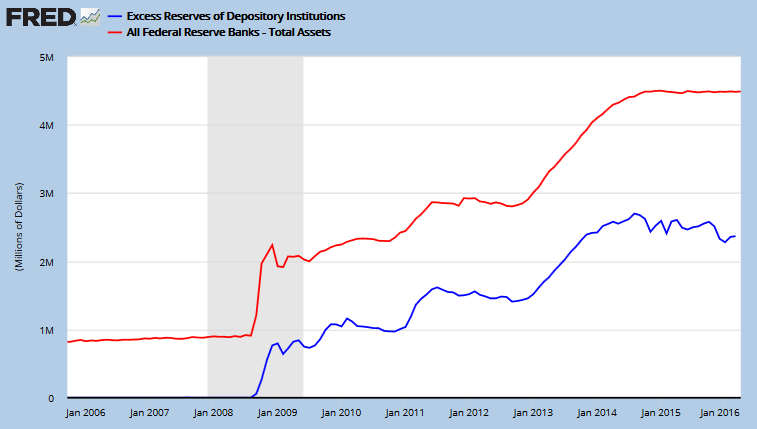
Fresh money continued to leak into the financial system as banks drew down their excess reserves, highlighted above by the widening gap between Total Assets and Excess Reserves. In December 2015 the Fed doubled the rate payable on excess reserves to 0.50% p.a. The intention is clearly to attract more excess reserves and narrow the gap, or at least slow the rate at which excess reserves are being withdrawn to prevent further widening.
Easy money policies followed by central banks around the world are not achieving the desired result of reviving business investment. If we examine the Fed's track record over the last two decades, sharp surges in business credit were accompanied by speculative bubbles — stocks ahead of the Dotcom crash and housing ahead of the GFC — with disastrous results. GDP failed to respond.
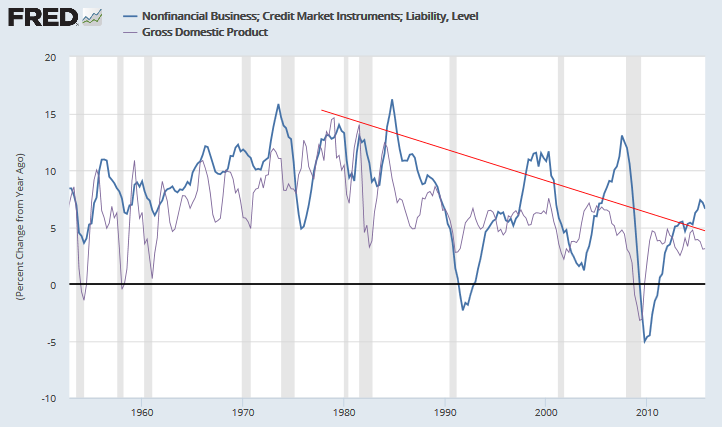
The latest rally in global markets is also driven by monetary easing, this time in China, with a massive surge in the money supply signaling PBOC intentions to print their way out of trouble (and into an even bigger hole).
Ineffectiveness of monetary policy in solving structural problems has often been described as "like pushing on a string". But recent experience shows it is more like lighting a fuse.
Global
Dow Jones Global Index is headed for a test of resistance at 320 after penetrating its descending trendline. Respect of 320 is likely but a bottom is forming and a higher trough would suggest an inverted head-and-shoulders formation. 13-Week Twiggs Momentum recovery above zero is bullish but another low peak would indicate that bears still dominate.
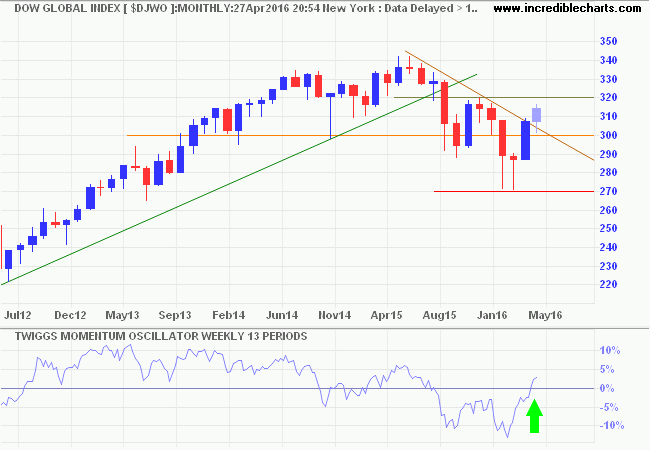
North America
The S&P 500 continues to test the band of resistance at 2100 to 2130. Money Flow remains bullish but I expect stubborn resistance at this level, further strengthened by poor quarterly results, so far, in the earnings season.
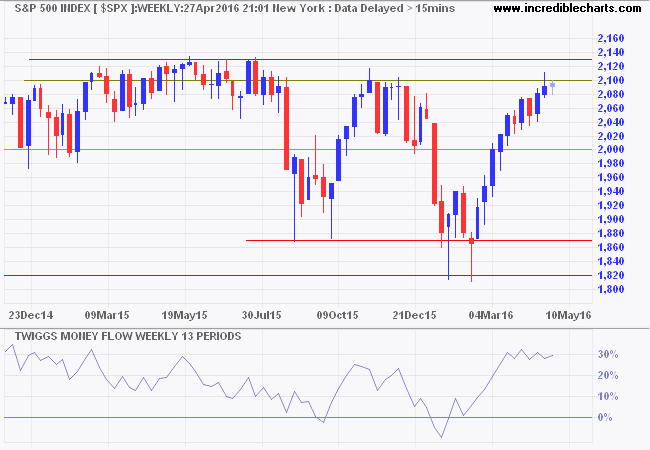
A CBOE Volatility Index (VIX) at a low 14 indicates that (short-term) market risk is low. Long-term measures are also starting to ease but we maintain high cash levels in our portfolios.
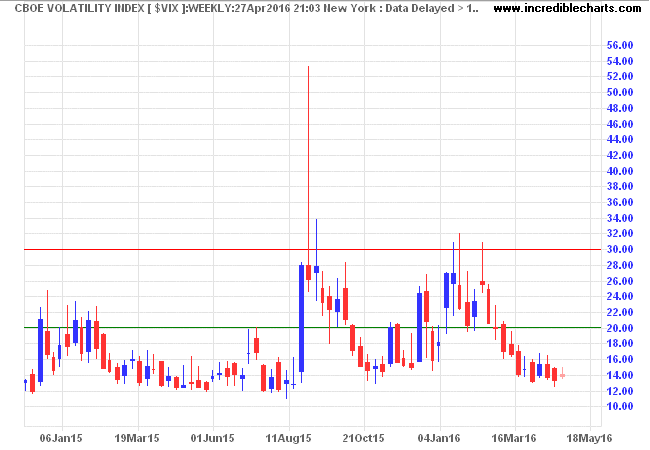
Canada's TSX 60 is headed for a test of resistance at 825. Penetration of the descending trendline suggests that a bottom is forming. Resistance is likely to hold but an ensuing higher trough would be a bullish sign. Rising 13-week Twiggs Momentum is encouraging but a low peak above zero would indicate that bears still dominate.
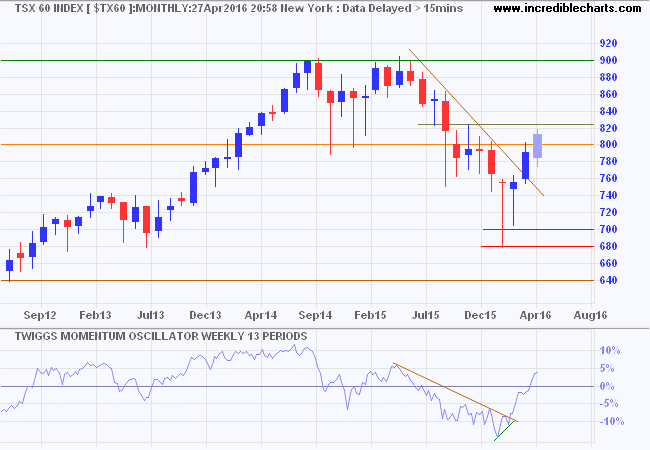
Europe
Germany's DAX broke resistance at 10000 and is headed for a test of the descending trendline. Rising Money Flow indicates medium-term buying pressure. Retreat below 10000 would warn of another decline.
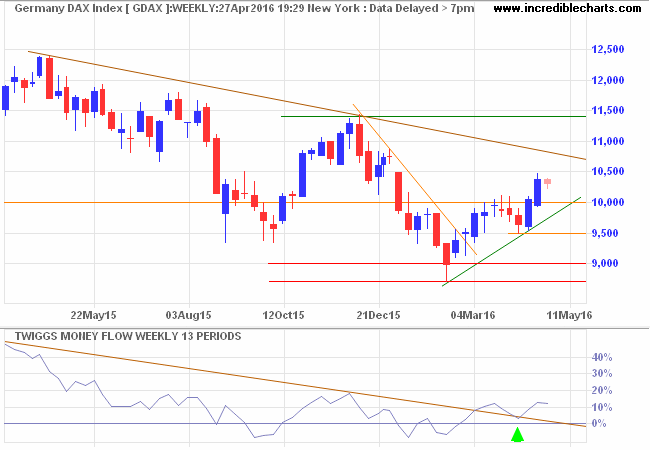
* Target calculation: 9500 - ( 11000 - 9500 ) = 8000
The Footsie is headed for a test of 6500. Rising Money Flow suggests decent buying pressure. Respect of resistance is likely but a bottom is forming and an ensuing higher trough would suggest a primary up-trend.
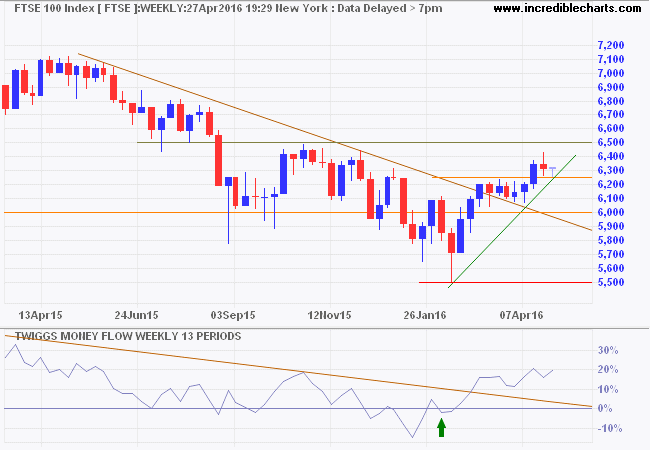
* Target calculation: 6000 - ( 6500 - 6000 ) = 5500
Asia
The Shanghai Composite Index retreated below 3000. Breach of medium-term support at 2900 would warn of another test of primary support at 2700. Rising Money Flow suggests that breach of primary support is unlikely.
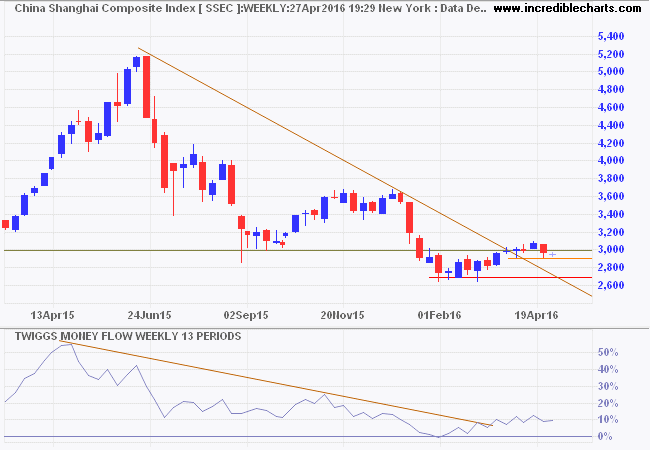
* Target calculation: 3000 - ( 3600 - 3000 ) = 2400
Japan's Nikkei 225 Index broke resistance at 17000, a higher trough signaling a primary up-trend. Expect retracement to test the new support level at 17000. Rising Money Flow confirms buying pressure.
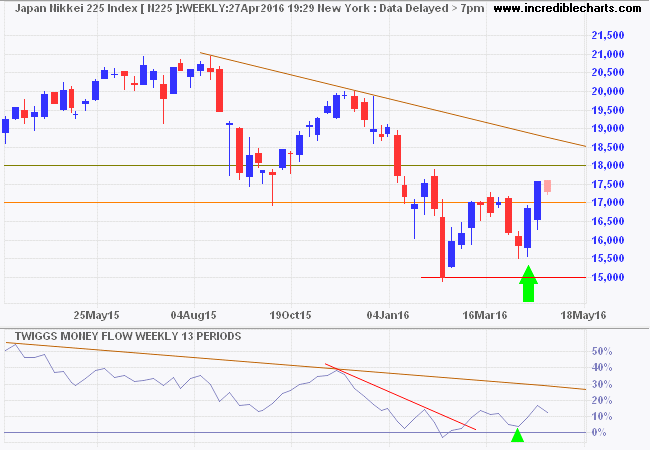
* Target calculation: 17000 - ( 20000 - 17500 ) = 15000
India's Sensex is testing its upper trend channel at 26000. Penetration of the descending trendline would suggest that a bottom is forming. Respect, indicated by reversal below 25000, would warn of another test of primary support.
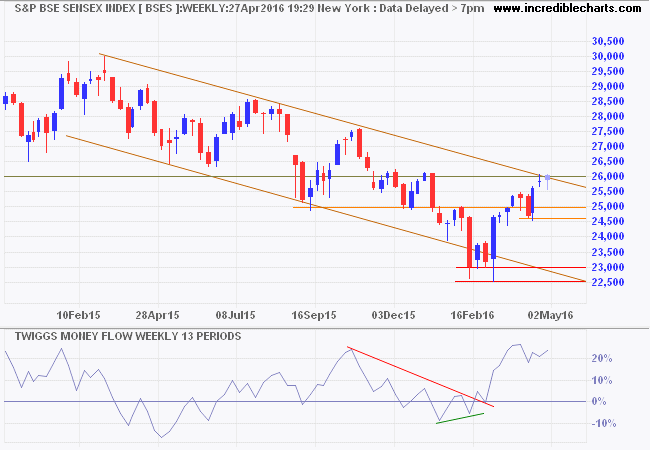
* Target calculation: 23000 - ( 25000 - 23000 ) = 21000
Australia
A sharp fall in the Australian Dollar as result of record low inflation numbers may precipitate some selling by international buyers. Further weakness in iron ore would impact both the ASX and the Aussie Dollar.
The ASX 200 has also penetrated its descending trendline, suggesting that a bottom is forming. But bearish divergence on 13-week Money Flow warns of selling pressure. Retreat below 5000 would warn of another test of primary support at 4700.
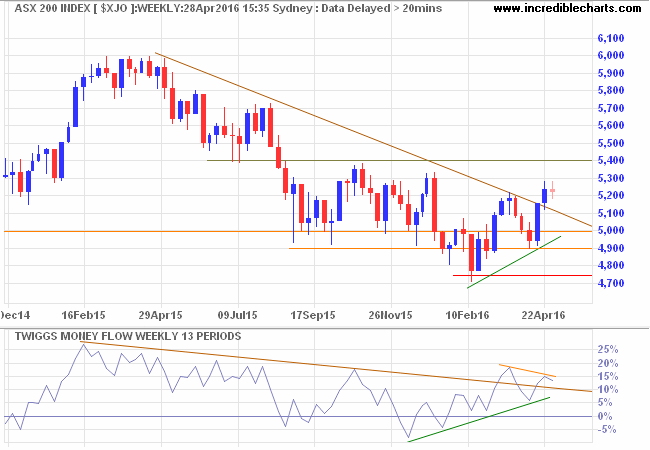
* Target calculation: 4700 - ( 5200 - 4700 ) = 4200
This is a nightmare, which will pass away with the morning. For the resources of nature and men's devices are just as fertile and productive as they were. The rate of our progress towards solving the material problems of life is not less rapid. We are as capable as before of affording for everyone a high standard of life .... and will soon learn to afford a standard higher still. We were not previously deceived. But to-day we have involved ourselves in a colossal muddle, having blundered in the control of a delicate machine, the working of which we do not understand. The result is that our possibilities of wealth may run to waste for a time - perhaps for a long time.
~ John Maynard Keynes: The Great Slump of 1930
Disclaimer
Porter Private Clients Pty Ltd, trading as Research & Investment ("R&I"), is a Corporate Authorized Representative (AR Number 384 397) of Andika Pty Ltd which holds an Australian Financial Services Licence (AFSL 297069).
The information on this web site and in the newsletters is general in nature and does not consider your personal circumstances. Please contact your professional financial adviser for advice tailored to your needs.
R&I has made every effort to ensure the reliability of the views and recommendations expressed in the reports published on its websites and newsletters. Our research is based upon information known to us or which was obtained from sources which we believe to be reliable and accurate.
No guarantee as to the capital value of investments, nor future returns are made by R&I. Neither R&I nor its employees make any representation, warranty or guarantee that the information provided is complete, accurate, current or reliable.
You are under no obligation to use these services and should always compare financial services/products to find one which best meets your personal objectives, financial situation or needs.
To the extent permitted by law, R&I and its employees, agents and authorised representatives exclude all liability for any loss or damage (including indirect, special or consequential loss or damage) arising from the use of, or reliance on, any information. If the law prohibits the exclusion of such liability, such liability shall be limited, to the extent permitted by law, to the resupply of the said information or the cost of the said resupply.
Important Warning About Simulated Results
Research & Investment (R&I) specialise in developing, testing and researching investment strategies and systems. Within the R&I web site and newsletters, you will find information about investment strategies and their performance. It is important that you understand that results from R&I research are simulated and not actual results.
No representation is made that any investor will or is likely to achieve profits or losses similar to those shown.
Simulated performance results are generally prepared with the benefit of hindsight and do not involve financial risk. No modeling can completely account for the impact of financial risk in actual investment. Account size, brokerage and slippage may also diverge from simulated results. Numerous other factors related to the markets in general or to the implementation of any specific investment system cannot be fully accounted for in the preparation of simulated performance results and may adversely affect actual investment results.
To the extent permitted by law, R&I and its employees, agents and authorised representatives exclude all liability for any loss or damage (including indirect, special or consequential loss or damage) arising from the use of, or reliance on, any information offered by R&I whether or not caused by any negligent act or omission.

Author: Colin Twiggs is a former investment banker with almost 40 years of experience in financial markets. He co-founded Incredible Charts and writes the popular Trading Diary and Patient Investor newsletters.
Using a top-down approach, Colin identifies key macro trends in the global economy before evaluating selected opportunities using a combination of fundamental and technical analysis.
Focusing on interest rates and financial market liquidity as primary drivers of the economic cycle, he warned of the 2008/2009 and 2020 bear markets well ahead of actual events.
He founded PVT Capital (AFSL No. 546090) in May 2023, which offers investment strategy and advice to wholesale clients.
